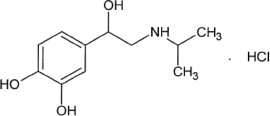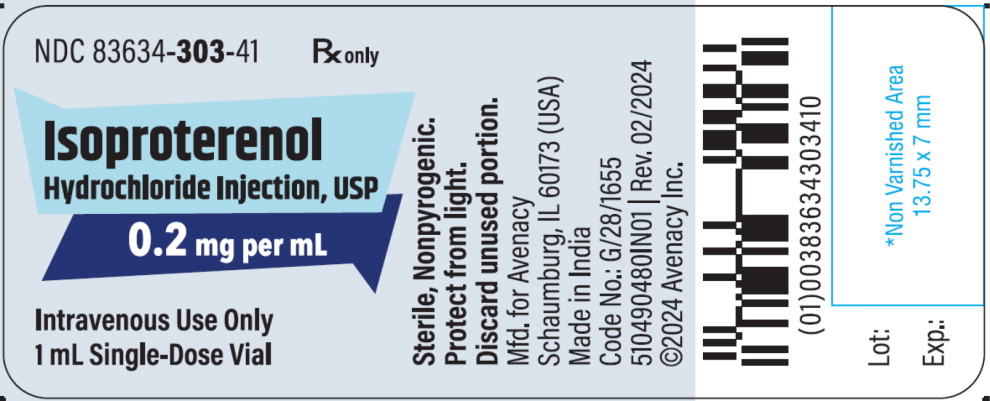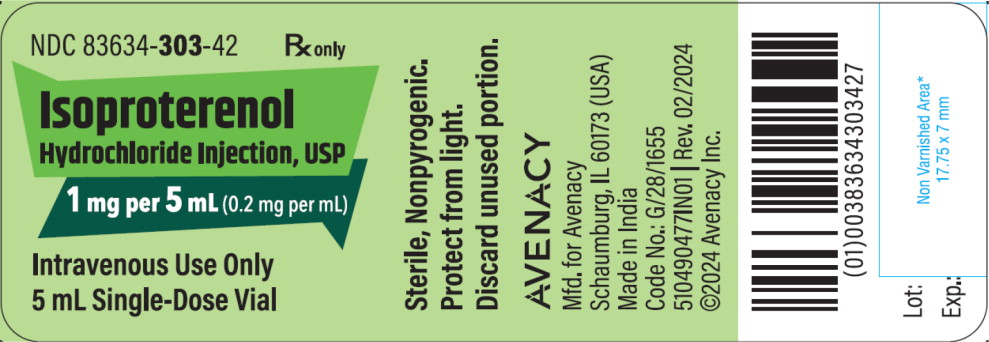ISOPROTERENOL HYDROCHLORIDE injection, solution
Isoproterenol Hydrochloride by
Drug Labeling and Warnings
Isoproterenol Hydrochloride by is a Prescription medication manufactured, distributed, or labeled by Avenacy, Inc.. Drug facts, warnings, and ingredients follow.
Drug Details [pdf]
-
HIGHLIGHTS OF PRESCRIBING INFORMATION
These highlights do not include all the information needed to use ISOPROTERENOL HYDROCHLORIDE INJECTION safely and effectively. See full prescribing information for ISOPROTERENOL HYDROCHLORIDE INJECTION.
ISOPROTERENOL HYDROCHLORIDE injection, for intravenous use
Initial U.S. Approval: 1956INDICATIONS AND USAGE
DOSAGE AND ADMINISTRATION
DOSAGE FORMS AND STRENGTHS
Injection: 0.2 mg per mL and 1 mg per 5 mL (0.2 mg per mL) single-dose vial (3)
CONTRAINDICATIONS
WARNINGS AND PRECAUTIONS
ADVERSE REACTIONS
Common adverse reactions with isoproterenol include tachycardia and palpitations (6)
To report SUSPECTED ADVERSE REACTIONS, contact Avenacy Inc. at 1-855-283-6229 or FDA at 1-800-FDA-1088 or www.fda.gov/medwatch.
DRUG INTERACTIONS
- Do not administer isoproterenol hydrochloride injection and epinephrine simultaneously due to combined effects may induce serious arrhythmias (7)
- Concomitant use of tricyclic antidepressants, monoamine oxidase inhibitors, levothyroxine sodium and certain antihistamines; hemodynamic parameters may potentiate a clinical response of isoproterenol (7)
- Beta-adrenergic blocking drugs may reduce cardiostimulating and bronchodilating effects of isoproterenol (7)
Revised: 2/2024
-
Table of Contents
FULL PRESCRIBING INFORMATION: CONTENTS*
1 INDICATIONS AND USAGE
2 DOSAGE AND ADMINISTRATION
2.1 General Considerations
2.2 Recommended Dosage
3 DOSAGE FORMS AND STRENGTHS
4 CONTRAINDICATIONS
5 WARNINGS AND PRECAUTIONS
5.1 Cardiac Arrhythmias and Ischemia
5.2 Allergic Reactions Associated with Sulfite
6 ADVERSE REACTIONS
7 DRUG INTERACTIONS
8 USE IN SPECIFIC POPULATIONS
8.1 Pregnancy
8.2 Lactation
8.4 Pediatric Use
8.5 Geriatric Use
10 OVERDOSAGE
11 DESCRIPTION
12 CLINICAL PHARMACOLOGY
12.1 Mechanism of Action
12.2 Pharmacodynamics
12.3 Pharmacokinetics
13 NONCLINICAL TOXICOLOGY
13.1 Carcinogenesis, Mutagenesis, Impairment of Fertility
16 HOW SUPPLIED/STORAGE AND HANDLING
- * Sections or subsections omitted from the full prescribing information are not listed.
- 1 INDICATIONS AND USAGE
-
2 DOSAGE AND ADMINISTRATION
2.1 General Considerations
Inspect visually for particulate matter and discoloration prior to administration, whenever solution and container permit. Do not use if the injection is pinkish or darker than slightly yellow or contains a precipitate. Discard any unused portion.
Diluted solution should be used immediately. Unused material should be discarded.
2.2 Recommended Dosage
Dosage should generally be started at the lowest recommended dose and increased gradually based on patient response.
Recommended dosage for adults with shock and hypoperfusion states: † Concentrations up to 10 times greater have been used when limitation of volume is essential.
†† Rates over 30 mcg per minute have been used in advanced stages of shock. Adjust the rate of infusion based on heart rate, central venous pressure, systemic blood pressure, and urine flow. If the heart rate exceeds 110 beats per minute, consider decreasing or temporarily discontinuing the infusion.
Route of Administration Preparation of Dilution† Infusion Rate†† Intravenous infusion Dilute 5 mL (1 mg) in 500 mL of 5% Dextrose Injection, USP 0.5 mcg to 5 mcg per minute (0.25 mL to 2.5 mL of diluted solution) Recommended dosage for adults with bronchospasm occurring during anesthesia: Route of Administration Preparation of Dilution Initial Dose Subsequent Dose Bolus
intravenous injectionDilute 1 mL (0.2 mg) to
10 mL with Sodium Chloride Injection, USP, or 5% Dextrose Injection, USP10 mcg to 20 mcg
(0.5 mL to 1 mL of diluted solution)The initial dose may
be repeated when necessaryThere are no well-controlled studies in children to establish appropriate dosing; however, the American Heart Association recommends an initial infusion rate of 0.1 mcg/kg/min, with the usual range being 0.1 mcg/kg/min to 1 mcg/kg/min.
- 3 DOSAGE FORMS AND STRENGTHS
- 4 CONTRAINDICATIONS
-
5 WARNINGS AND PRECAUTIONS
5.1 Cardiac Arrhythmias and Ischemia
Isoproterenol may induce cardiac arrhythmias and myocardial ischemia in patients, especially patients with coronary artery disease, or cardiomyopathy.
5.2 Allergic Reactions Associated with Sulfite
Isoproterenol hydrochloride injection contains sodium metabisulfite, which may cause mild to severe allergic reactions including anaphylaxis or asthmatic episodes, particularly in patients with a history of allergies. However, the presence of metabisulfite in this product should not preclude its use for treatment in emergency situations, even if the patient is sulfite-sensitive, as the alternatives to using isoproterenol in a life-threatening situation may not be satisfactory.
-
6 ADVERSE REACTIONS
The following adverse reactions have been associated with use of isoproterenol. Because these reactions are reported voluntarily from a population of uncertain size, it is not always possible to estimate their frequency reliably or to establish a causal relationship to drug exposure.
Nervous system disorders: Nervousness, headache, dizziness, visual blurring
Cardiovascular: Tachycardia, tachyarrhythmias, palpitations, angina, ventricular arrhythmias, Adams-Stokes attacks, pulmonary edema
Respiratory: Dyspnea
Other: Flushing of the skin, sweating, mild tremors, pallor, nausea
-
7 DRUG INTERACTIONS
Table 1: Clinically Relevant Interactions with Isoproterenol Epinephrine Clinical Impact Both drugs are direct cardiac stimulants, and their combined effects may induce serious arrhythmias upon simultaneous administration. Intervention Isoproterenol hydrochloride injection and epinephrine should not be administered simultaneously. Drugs that may potentiate clinical response of Isoproterenol Clinical Impact The effects of isoproterenol may be potentiated by tricyclic antidepressants, monoamine oxidase inhibitors, levothyroxine sodium, and certain antihistamines, notably chlorpheniramine, tripelennamine, and diphenhydramine. Intervention Monitor hemodynamic parameters in patients who concurrently are taking tricyclic antidepressants, monoamine oxidase inhibitors, levothyroxine sodium and certain antihistamines. Adjust doses appropriately. Drugs that may reduce clinical response of Isoproterenol Clinical Impact The cardiostimulating and bronchodilating effects of isoproterenol are antagonized by beta-adrenergic blocking drugs, such as propranolol. Intervention Monitor for hemodynamic response and relief of bronchospasm and adjust dose appropriately. -
8 USE IN SPECIFIC POPULATIONS
8.1 Pregnancy
Risk Summary
Prolonged experience with isoproterenol use in pregnant women over several decades, based on published literature, do not identify a drug associated risk of major birth defects, miscarriage or adverse maternal or fetal outcomes. However, there are risks to the mother and fetus associated with isoproterenol use during labor or delivery [see Clinical Considerations].
The estimated background risk of major birth defects and miscarriage for the indicated population is unknown. All pregnancies have a background risk of birth defect, loss, or other adverse outcomes. In the United States general population, the estimated background risk of major birth defects and miscarriage in clinically recognized pregnancies is 2 to 4% and 15 to 20%, respectively.
Clinical Considerations
Hypotension associated with shock is a medical emergency in pregnancy which can be fatal if left untreated. Delaying treatment in pregnant women with hypotension associated with shock may increase the risk of maternal and fetal morbidity and mortality. Life-sustaining therapy for the pregnant woman should not be withheld due to potential concerns regarding the effects of isoproterenol on the fetus.
Labor and Delivery
Isoproterenol usually inhibits spontaneous or oxytocin induced contractions of the pregnant human uterus and may delay the second stage of labor. Avoid isoproterenol during the second stage of labor. Avoid isoproterenol in obstetrics when maternal blood pressure exceeds 130/80 mmHg.
Although isoproterenol may improve maternal hypotension associated with shock, it may result in uterine vasoconstriction, decreased uterine blood flow, uterine atony with hemorrhage, and fetal anoxia.
8.4 Pediatric Use
Safety and efficacy of isoproterenol in pediatric patients have not been established.
Intravenous infusions of isoproterenol in refractory asthmatic children at rates of 0.05 to 2.7 μg/kg/min have caused clinical deterioration, myocardial necrosis, congestive heart failure and death. The risks of cardiac toxicity appear to be increased by some factors [acidosis, hypoxemia, coadministration of corticosteroids, coadministration of methylxanthines (theophylline, theobromine) or aminophylline] that are especially likely to be present in these patients. If I.V. isoproterenol is used in children with refractory asthma, patient monitoring must include continuous assessment of vital signs, frequent electrocardiography, and daily measurements of cardiac enzymes, including CPK-MB.
8.5 Geriatric Use
Clinical studies of isoproterenol hydrochloride injection did not include sufficient numbers of subjects aged 65 and over to determine whether they respond differently from younger subjects in clinical circumstances. There are, however, some data that suggest that elderly healthy or hypertensive patients are less responsive to beta-adrenergic stimulation than are younger subjects. In general, dose selection for elderly patients should be cautious, usually starting at the low end of the dosing range, reflecting the greater frequency of decreased hepatic, renal or cardiac function and of concomitant diseases or other drug therapy.
-
10 OVERDOSAGE
Overdosage of isoproterenol can cause tachycardia or other arrhythmias, palpitations, angina, hypotension, or hypertension. In case of overdosage, reduce the rate of administration or discontinue isoproterenol hydrochloride injection until patient's condition stabilizes. Monitor blood pressure, pulse, respiration, and EKG.
It is not known whether isoproterenol hydrochloride is dialyzable.
-
11 DESCRIPTION
Isoproterenol hydrochloride, USP is 3,4-Dihydroxy-α-[(isopropylamino)methyl] benzyl alcohol hydrochloride, a beta-adrenergic agonist and a synthetic sympathomimetic amine that is structurally related to epinephrine. The molecular formula is C11H17NO3 · HCl. It has a molecular weight of 247.72 and the following structural formula:
Isoproterenol hydrochloride is a racemic compound.
Each milliliter of the sterile solution contains: Isoproterenol hydrochloride, USP 0.2 mg Edetate Disodium (EDTA) 0.2 mg Sodium Citrate Dihydrate 2.07 mg Citric Acid, Anhydrous 2.5 mg Sodium Chloride 7.0 mg Water for Injection qs 1.0 mL The pH is adjusted between 2.5 and 3.5 with hydrochloric acid and/or sodium hydroxide. The sterile solution is nonpyrogenic and can be administered by the intravenous route.
-
12 CLINICAL PHARMACOLOGY
12.1 Mechanism of Action
Isoproterenol is a potent nonselective beta-adrenergic agonist with very low affinity for alpha-adrenergic receptors.
12.2 Pharmacodynamics
Intravenous infusion of isoproterenol in man lowers peripheral vascular resistance, primarily in skeletal muscle but also in renal and mesenteric vascular beds. Diastolic pressure falls. Renal blood flow is decreased in normotensive subjects but is increased markedly in shock. Systolic blood pressure may remain unchanged or rise, although mean arterial pressure typically falls. Cardiac output is increased because of the positive inotropic and chronotropic effects of the drug in the face of diminished peripheral vascular resistance.
Isoproterenol relaxes almost all varieties of smooth muscle when the tone is high, but this action is most pronounced on bronchial and gastrointestinal smooth muscle. It prevents or relieves bronchoconstriction, but tolerance to this effect develops with overuse of the drug.
In man, isoproterenol causes less hyperglycemia than does epinephrine. Isoproterenol and epinephrine are equally effective in stimulating the release of free fatty acids and energy production.
12.3 Pharmacokinetics
Elimination
Isoproterenol is metabolized primarily in the liver and other tissues by COMT. Isoproterenol is a relatively poor substrate for MAO and is not taken up by sympathetic neurons to the same extent as are epinephrine and norepinephrine. The duration of action of isoproterenol may therefore be longer than that of epinephrine but is still brief.
-
13 NONCLINICAL TOXICOLOGY
13.1 Carcinogenesis, Mutagenesis, Impairment of Fertility
Long-term studies in animals to evaluate the carcinogenic potential of isoproterenol hydrochloride have not been done. Mutagenic potential and effect on fertility have not been determined. There is no evidence from human experience that isoproterenol hydrochloride injection may be carcinogenic or mutagenic or that it impairs fertility.
-
16 HOW SUPPLIED/STORAGE AND HANDLING
Isoproterenol Hydrochloride Injection, USP is supplied as follows:
NDC Isoproterenol Hydrochloride Injection, USP
(0.2 mg per mL)Package Factor 83634-303-01 0.2 mg per 1 mL Single-Dose Vial 10 vials per carton 83634-303-05 1 mg per 5 mL Single-Dose Vial 10 vials per carton Storage Conditions
Store at 20° to 25°C (68° to 77°F); excursions permitted between 15° and 30°C (59° and 86°F). [See USP Controlled Room Temperature.]
Protect from light. Keep in opaque container until used.
Do not use if the injection is pinkish or darker than slightly yellow or contains a precipitate.
Discard unused portion.
Sterile, Nonpyrogenic.
The container closure is not made with natural rubber latex.AVENACY
Mfd. for Avenacy
Schaumburg, IL 60173 (USA)
Made in India
©2024 Avenacy Inc.Revised: February 2024
-
PRINCIPAL DISPLAY PANEL
PACKAGE LABEL – PRINCIPAL DISPLAY PANEL – Vial Label
NDC: 83634-303-41
Isoproterenol Hydrochloride Injection, USP
0.2 mg per mL
Rx only
Intravenous Use Only
1 mL Single-Dose Vial
-
PRINCIPAL DISPLAY PANEL
PACKAGE LABEL – PRINCIPAL DISPLAY PANEL – Vial Label
NDC: 83634-303-42
Isoproterenol Hydrochloride Injection, USP
1 mg per 5 mL (0.2 mg per mL)
Rx only
Intravenous Use Only
5 mL Single-Dose Vial
-
INGREDIENTS AND APPEARANCE
ISOPROTERENOL HYDROCHLORIDE
isoproterenol hydrochloride injection, solutionProduct Information Product Type HUMAN PRESCRIPTION DRUG Item Code (Source) NDC: 83634-303 Route of Administration INTRAVENOUS Active Ingredient/Active Moiety Ingredient Name Basis of Strength Strength isoproterenol hydrochloride (UNII: DIA2A74855) (isoproterenol - UNII:L628TT009W) isoproterenol hydrochloride 0.2 mg in 1 mL Inactive Ingredients Ingredient Name Strength edetate disodium (UNII: 7FLD91C86K) sodium chloride (UNII: 451W47IQ8X) trisodium citrate dihydrate (UNII: B22547B95K) anhydrous citric acid (UNII: XF417D3PSL) sodium hydroxide (UNII: 55X04QC32I) hydrochloric acid (UNII: QTT17582CB) water (UNII: 059QF0KO0R) Packaging # Item Code Package Description Marketing Start Date Marketing End Date 1 NDC: 83634-303-01 10 in 1 CARTON 05/15/2024 1 NDC: 83634-303-41 1 mL in 1 VIAL, SINGLE-DOSE; Type 0: Not a Combination Product 2 NDC: 83634-303-05 10 in 1 CARTON 05/15/2024 2 NDC: 83634-303-42 5 mL in 1 VIAL, SINGLE-DOSE; Type 0: Not a Combination Product Marketing Information Marketing Category Application Number or Monograph Citation Marketing Start Date Marketing End Date ANDA ANDA212189 05/15/2024 Labeler - Avenacy, Inc. (119060628)
© 2025 FDA.report
This site is not affiliated with or endorsed by the FDA.


